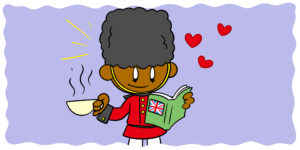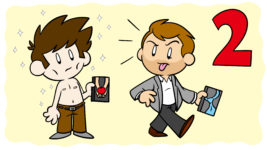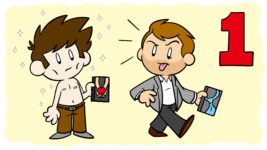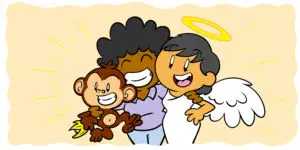Setting is one of the most underutilized devices available to an author. Though often less fun to write than action or dialogue, setting is versatile and can do a lot for your story and characters.
Unless you’re making a specific effort to avoid it, all stories feature some kind of setting. In fact, it’s likely that you’re already using setting to establish the themes and tone of your story, even if you don’t know it, using a device called pathetic fallacy.
Pathetic fallacy
Pathetic fallacy is when you attribute a personality to nature. Most commonly it’s subtle, and simply involves matching the setting of a story to its mood. Happy events happen in the sun while miserable characters get to skulk around in the rain. While it can be quite pronounced, like the crack of thunder as an insane scientist celebrates his unholy creation, most stories use pathetic fallacy to some extent.
This has little grounding in realism, and yet it has such an innate feeling of rightness to it that most readers will never question why the weather always perfectly serves the plot.
Mood weather
While the extent varies from person to person, science bears out that our mood is influenced by the weather. Since we’re more predisposed to happiness when it’s sunny, we subconsciously recognize a link between the two and accept the faulty backwards logic that happy scenes ‘belong’ in the sun.
This logic extends to locations where we feel safe or threatened. Life experiences are not tethered to location, love and conflict can happen anywhere, and yet every reader has the same understanding of where plot points naturally take place.
What this means for the writer is that there’s an existing language of setting that they can use to steer the reader’s expectations and experience.
Priming the reader
Because weather and setting set the emotional tone and plot expectations of a reader, they are an incredibly subtle way of explaining the core themes and occurrences in your story. In Wuthering Heights, Emily Brontë explores the value of love and the devastating consequences of its absence. The story is famously set on the Yorkshire moors, a setting which communicates the key themes of the book even before the reader meets the main characters.
The moors are treated as a beautiful but dangerous terrain. Beatific when viewed from the safety of a house, they are tumultuous, often subject to terrifying storms. Wandering on the moors is an adventure, but one from which you might not return. Brontë uses the moors as a metaphor for human passion, offering an explanation for her characters and world.
The following passage describes a natural landmark, but also prepares the reader for the character of Heathcliff. Like the crags, he will prove to be dangerously inaccessible though resplendent, even awe-inspiring, when surrounded by less passionate characters:
The abrupt descent of Penistone Crags particularly attracted her notice; especially when the setting sun shone on it and the topmost heights, and the whole extent of landscape besides lay in shadow. I explained that they were bare masses of stone, with hardly enough earth in their clefts to nourish a stunted tree.
‘And why are they bright so long after it is evening here?’ she pursued.
‘Because they are a great deal higher up than we are,’ replied I; ‘you could not climb them, they are too high and steep. In winter the frost is always there before it comes to us; and deep into summer I have found snow under that black hollow on the north-east side!’
Heathcliff is never mentioned, and yet the ideas that define him have already been illustrated. Majesty is set aside from emotional fulfillment, and so when Heathcliff follows this path it feels as real and natural as the hills.
In this manner, writers can have a reader accept their plot before it’s even begun, so that when events or character correspond to the setting, the reader recognizes this correlation as a deep truth. This is a key device in the writer’s tool box, and can even be used in reverse.
Reverse priming
Of course, the writer doesn’t always want the reader to have a head start on the story. As detailed in our article on crime fiction, sometimes juxtaposition between setting and plot can also serve the story:
The more Eden-like [the setting], the greater the contradiction of murder. The country is preferable to the town, a well-to-do neighborhood better than a slum. The corpse must shock not only because it is a corpse but also because, even for a corpse, it is shockingly out of place, as when a dog makes a mess on a drawing room carpet.
– W.H. Auden
Having your setting at odds with the events that occur in it creates a jarring effect, but sometimes you want the reader to feel jarred. The first chapter of Ian McEwan’s Enduring Love details a horrifying balloon accident that drags in a group of unprepared characters. The protagonist is on a picnic in a sunny field and so when the grisly accident occurs he, and the reader, is even more affected by the events that do not belong in that setting:
The beginning is simple to mark. We were in sunlight under a turkey oak, partly protected from a strong, gusty wind. I was kneeling on the grass with a corkscrew in my hand, and Clarissa was passing me the bottle – a 1987 Daumas Gassac. This was the moment, this was the pinprick on the time map: I was stretching out my hand, and as the cool neck and the black foil touched my palm, we heard a man’s shout. We turned to look across the field and saw the danger. Next thing, I was running towards it. The transformation was absolute: I don’t recall dropping the corkscrew, or getting to my feet, or making a decision, or hearing the caution Clarissa called after me. What idiocy, to be racing into this story and its labyrinths, sprinting away from our happiness among the fresh spring grasses by the oak. There was the shout again, and a child’s cry, enfeebled by the wind that roared in the tall trees among the hedgerows.
The use of wind in this extract is particularly illustrative. First it is used to communicate comfort, the picnic is pleasant because the characters are ‘partly protected’ from it, and then as part of the threat.
This same device is why romantic stories often feature a scene where characters kiss in the rain. The setting is not conducive to romance and so, when romance happens, it creates the impression that the emotion is so pronounced as to have broken the boundaries of ‘how things work’. While a good example of reverse priming, this particular example has been used so much that readers have learnt the trick and perceive rain in a romantic story as a cue for a kiss.
Harnessing setting
Setting allows the reader to address the themes of a story surprisingly directly while still being considered subtle. It can be used to establish tone, to develop characters or to heighten dramatic moments.
The natural world is seen as truthful and yet its representation is entirely in the hands of the author, so it’s perfect for communicating the rules of a story or world. When Shakespeare wants to communicate that Macbeth’s rule is wrong, his most powerful device isn’t the ghost of a friend or the madness of his wife, both of which are powerful emotional tools, but that nature has become corrupted:
Ross: Ah, good father,
Thou seest, the heavens, as troubled with man’s act,
Threaten his bloody stage: by the clock, ’tis day,
And yet dark night strangles the travelling lamp:
Is’t night’s predominance, or the day’s shame,
That darkness does the face of earth entomb,
When living light should kiss it?Old Man: ‘Tis unnatural,
Even like the deed that’s done. On Tuesday last,
A falcon, towering in her pride of place,
Was by a mousing owl hawk’d at and kill’d.Ross: And Duncan’s horses–a thing most strange and certain–
Beauteous and swift, the minions of their race
Turn’d wild in nature, broke their stalls, flung out,
Contending ‘gainst obedience, as they would make
War with mankind.Old Man: ‘Tis said they eat each other.
Moral theories are different for everyone, characters will be perceived differently depending on the reader, but setting offers the writer an immediately comprehensible and unquestioned standard by which the rest of the story can be understood. Do little flowers prosper, or are they choked by bigger plants? Are cities a haven from uncivilized nature or impersonal and fascistic? Describe your setting early and graphically to establish a worldview that you can then use or abuse to great effect.
Does a great setting make you feel like you’re in the story, or do you skip any passage that mentions the scenery? Either way, I’d love to hear from you in the comments. Or check out Should Authors Use Familiar Places As Story Settings? for more setting advice, and What A Blacksmith Knows About How To Fix Your Story for more on using seemingly unconnected plot elements in tandem.
Here's Why You Shouldn't Underestimate The Power Of SettingClick To Tweet





2 thoughts on “Here’s Why You Shouldn’t Underestimate The Power Of Setting”
I really should better my “setting parts”! Nice article, thanks!
Hi boostwriter,
No problem, hope it helps.
Best,
Rob